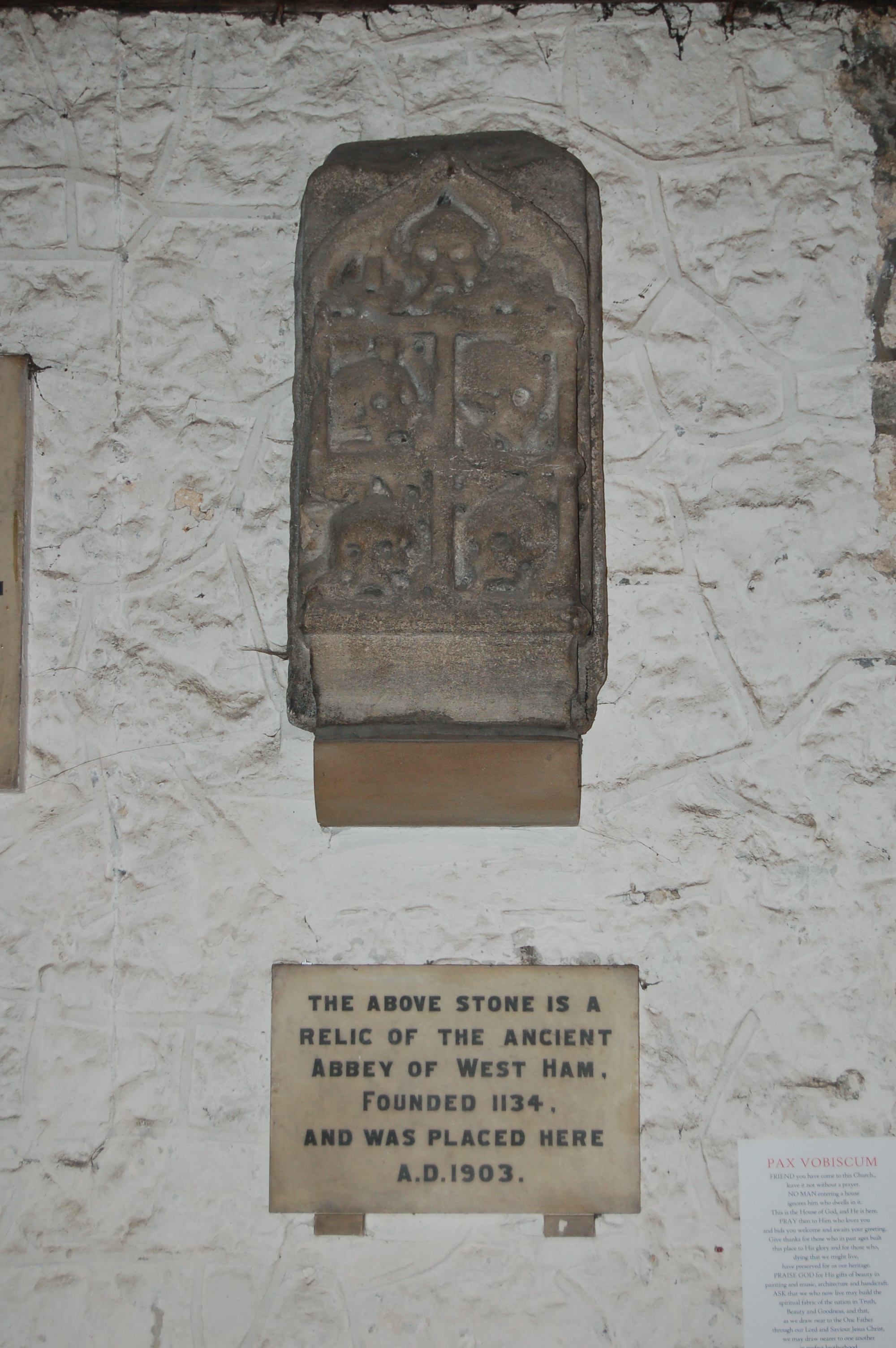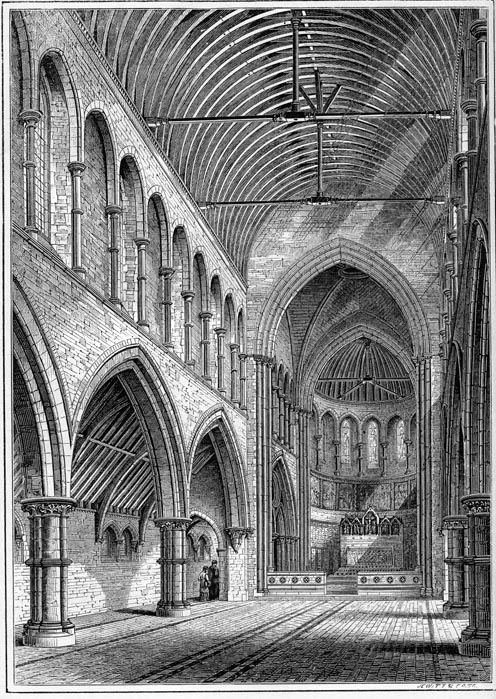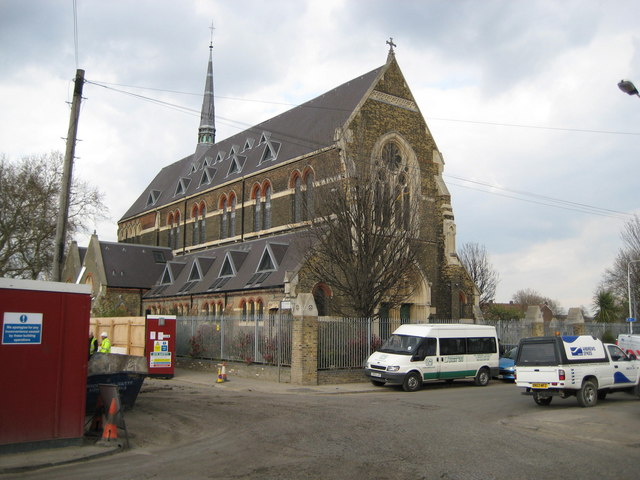|
St Gabriel's Church, West Ham
St Gabriel's Church, Canning Town was a Church of England church in Canning Town, east London. It originated as an undedicated iron church between the River Lea and the railway to the north of the Barking Road, on the site later used for the brick-built permanent church of St Gabriel's, consecrated in 1876. Initially a mission of All Saints Church, West Ham, it was given a parish of its own three years after the consecration, using parts of those of All Saints, St Mary's and St Andrew's. It was damaged in the London Blitz and demolished around 1955, with its parish split between St Matthias and St Luke's in 1961. References Gabriel Gabriel In Abrahamic religions (Judaism, Christianity and Islam), Gabriel (); Greek: grc, Γαβριήλ, translit=Gabriḗl, label=none; Latin: ''Gabriel''; Coptic: cop, Ⲅⲁⲃⲣⲓⲏⲗ, translit=Gabriêl, label=none; Amharic: am, ገብ� ... 1876 establishments in England 19th-century Church of England church buildings< ... [...More Info...] [...Related Items...] OR: [Wikipedia] [Google] [Baidu] |
Church Of England
The Church of England (C of E) is the established Christian church in England and the mother church of the international Anglican Communion. It traces its history to the Christian church recorded as existing in the Roman province of Britain by the 3rd century and to the 6th-century Gregorian mission to Kent led by Augustine of Canterbury. The English church renounced papal authority in 1534 when Henry VIII of England, Henry VIII failed to secure a papal annulment of his marriage to Catherine of Aragon. The English Reformation accelerated under Edward VI of England, Edward VI's regents, before a brief Second Statute of Repeal, restoration of papal authority under Mary I of England, Queen Mary I and Philip II of Spain, King Philip. The Act of Supremacy 1558 renewed the breach, and the Elizabethan Settlement charted a course enabling the English church to describe itself as both English Reformation, Reformed and Catholicity, Catholic. In the earlier phase of the Eng ... [...More Info...] [...Related Items...] OR: [Wikipedia] [Google] [Baidu] |
Canning Town
Canning Town is a district in the London Borough of Newham, East London. The district is located to the north of the Royal Victoria Dock, and has been described as the "Child of the Victoria Docks" as the timing and nature of its urbanisation was largely due to the creation of the dock. The area was part of the ancient parish of West Ham, in the hundred of Becontree, and part of the historic county of Essex. It forms part of the London E16 postcode district. The area, the location of the Rathbone Market, is undergoing significant regeneration . According to Newham Council: "The Canning Town and Custom House Regeneration Programme includes the building of up to 10,000 new homes, creation of thousands of new jobs and two improved town centres. This £3.7 billion project aims to transform the area physically, socially and economically." History Prior to the 19th century, the district was largely marshland, and accessible only by boat, or a toll bridge. In 1809, an Act of ... [...More Info...] [...Related Items...] OR: [Wikipedia] [Google] [Baidu] |
Tin Tabernacle
A tin tabernacle, also known as an iron church, is a type of prefabricated ecclesiastical building made from corrugated galvanised iron. They were developed in the mid-19th century initially in the United Kingdom. Corrugated iron was first used for roofing in London in 1829 by civil engineer Henry Robinson Palmer, and the patent was later sold to Richard Walker who advertised "portable buildings for export" in 1832. The technology for producing the corrugated sheets improved, and to prevent corrosion, the sheets were galvanised with a coating of zinc, a process developed by Stanislas Sorel in Paris in the 1830s. After 1850, many types of prefabricated buildings were produced, including churches, chapels and mission halls. History The Industrial Revolution was a time of great population expansion and movement in Europe. Towns and cities expanded as the workforce moved into the new industrial areas resulting in the building of more than 4,000 churches during the mid 19th cen ... [...More Info...] [...Related Items...] OR: [Wikipedia] [Google] [Baidu] |
River Lea
The River Lea ( ) is in South East England. It originates in Bedfordshire, in the Chiltern Hills, and flows southeast through Hertfordshire, along the Essex border and into Greater London, to meet the River Thames at Bow Creek. It is one of the largest rivers in London and the easternmost major tributary of the Thames. The river's significance as a major east–west barrier and boundary has tended to obscure its importance as north–south trade route. Below Hertford the river has since medieval times had alterations made to make it more navigable for boats between the Thames and eastern Hertfordshire and Essex, known as the Lee Navigation. This stimulated much industry along its banks. The navigable River Stort, the main tributary, joins it at Hoddesdon. While the lower Lea remains somewhat polluted, its upper stretch and tributaries, classified as chalk streams, are a major source of drinking water for London. An artificial waterway known as the New River, opened ... [...More Info...] [...Related Items...] OR: [Wikipedia] [Google] [Baidu] |
All Saints Church, West Ham
All Saints Church is a parish church in West Ham, an area in east London. It has been a Grade I listed building since 1984. History Medieval and Tudor In the medieval era the church's parish included all of West Ham, with the one exception of the 24 acres within Stratford Langthorne Abbey's precincts, which formed a separate parish of St Mary and All Saints until the abbey was dissolved, that parish's church was destroyed and the parish itself merged into All Saints. There has been a building on the site since at least the late 12th century - the three blocked clerestory windows on either side of the present building's nave date to that time. One of the founding endowments for the Abbey was land that had belonged to "Ranulph the priest", implying the existence of a parish church. The first concrete reference is a charter of 1181-82 by Henry II of England which confirmed the church of West Ham to the abbey. Gilbert Foliot, bishop of London also assigned a vicar to the parish chur ... [...More Info...] [...Related Items...] OR: [Wikipedia] [Google] [Baidu] |
St Mary's Church, Plaistow
St Mary's Church is a Church of England church in Plaistow in the (East-) London Borough of Newham. With the three churches of St Matthias’, St Martin's, and St Philip and St James’, it now forms part of the Parish of the Divine Compassion. Its Victorian building, designed by Sir Arthur William Blomfield in 1890-1894, was demolished in 1976. They now worship in a smaller church built in 1981. It was built as a chapel of ease to All Saints Church, West Ham, then the only parish church in the area. It was promoted to a parish in its own right in 1844. The site was granted by Sir John H Pelly and the church designed in the neo-Gothic style influenced by the late Perpendicular style by Thomas Curtis. Notable among its vicars was Thomas Given-Wilson, who raised is capacity to 1,000 through a comprehensive rebuild. The parish also built several mission churches - St Peter's, Upton Road (1880s), St Katherine's on Chapman Road (1891; replaced by a permanent church in 1894; ... [...More Info...] [...Related Items...] OR: [Wikipedia] [Google] [Baidu] |
St Andrew's Church, Plaistow
St Andrew's Church was a Church of England church on Barking Road in Plaistow, east London. It began as a small mission built in 1860 on Whitwell Road by St Mary's Church, Plaistow. A permanent church designed by James Brooks opened in 1870 on a site just south of the northern outfall sewer embankment and a separate parish assigned to it the following year. A large central crossing tower with a pyramidal spire was planned but only completed as far as the ridge of the nave roof. In 1903 the church opened the mission hall that later became St Cedd's Church, Canning Town - the mission district for it was split off from the parishes of St Andrew's and St Luke's. St Andrew's suffered heavy damage during the London Blitz but was extensively repaired after 1945. The building was Grade II listed in 1984 but is no longer an Anglican church, now housing offices and a UCKG Help Centre and with its chancel walled off. Its parish is now within the Parish of the Divine Compassion. In 2006, th ... [...More Info...] [...Related Items...] OR: [Wikipedia] [Google] [Baidu] |
London Blitz
The Blitz was a German bombing campaign against the United Kingdom in 1940 and 1941, during the Second World War. The term was first used by the British press and originated from the term , the German word meaning 'lightning war'. The Germans conducted mass air attacks against industrial targets, towns, and cities, beginning with raids on London towards the end of the Battle of Britain in 1940 (a battle for daylight air superiority between the Luftwaffe and the Royal Air Force over the United Kingdom). By September 1940, the Luftwaffe had lost the Battle of Britain and the German air fleets () were ordered to attack London, to draw RAF Fighter Command into a battle of annihilation.Price 1990, p. 12. Adolf Hitler and Reichsmarschall Hermann Göring, commander-in-chief of the Luftwaffe, ordered the new policy on 6 September 1940. From 7 September 1940, London was systematically bombed by the Luftwaffe for 56 of the following 57 days and nights. Most notable was a large dayli ... [...More Info...] [...Related Items...] OR: [Wikipedia] [Google] [Baidu] |
St Matthias’ Church, Canning Town
St Matthias' Church is a Church of England parish church in Canning Town, east London. The modern building comprises a chapel, community rooms and a home for residents with disabilities. History The origins of St Matthias Church in Canning town are found in 1887 with a gospel mission from St Mary's Church, Plaistow. It was named after St Matthias' Church in Torquay, which had assisted with funding the mission. In 1906 the mission merged with that of St Cyprian on Beaconsfield Road. In 1907 a permanent church building was built and a parish formed. This parish contained sections of the parish of St Mary's, St Andrew's and St Gabriel's. In 1961 parts of the parish of Holy Trinity and more from St Gabriel's were added. With the three churches of St Mary's Church, St Martin's, and St Philip and St James’, it formed part of the Parish of the Divine Compassion. By 1989 the original church building was demolished and replaced in 1991 by an integrated chapel, community rooms and h ... [...More Info...] [...Related Items...] OR: [Wikipedia] [Google] [Baidu] |
St Luke's Church, Canning Town
St Luke's Church, Canning Town or St Luke's Church, Victoria Docks is a Church of England church, originally housed in a building on Boyd Road in the Royal Docks area of West Ham in east London. Planned by Henry Boyd, vicar of St Mark's Church, Silvertown, St Luke's was consecrated in 1875, with a parish split off from St Mark's. Built 1873-5 by Giles and Gane, its neo-Gothic architecture imitates the medieval Early English style and has a flèche rather than a tower. It later took on St Matthew's Church, Custom House (previously a mission of St Mark's itself). It also created a mission church of its own, the Church of the Ascension (1887–1905), a mission to lascar seamen from 1887 and a mission in Ford Park Road by 1890. It is a Grade II listed building, having been listed in 1994. It was badly damaged in 1940 during the London Blitz, though services continued in a garage and then in the church hall. Temporary repairs to the church in 1949 were followed by permanent recons ... [...More Info...] [...Related Items...] OR: [Wikipedia] [Google] [Baidu] |
Former Church Of England Church Buildings
A former is an object, such as a template, gauge or cutting die, which is used to form something such as a boat's hull. Typically, a former gives shape to a structure that may have complex curvature. A former may become an integral part of the finished structure, as in an aircraft fuselage, or it may be removable, being using in the construction process and then discarded or re-used. Aircraft formers Formers are used in the construction of aircraft fuselage, of which a typical fuselage has a series from the nose to the empennage, typically perpendicular to the longitudinal axis of the aircraft. The primary purpose of formers is to establish the shape of the fuselage and reduce the column length of stringers to prevent instability. Formers are typically attached to longerons, which support the skin of the aircraft. The "former-and-longeron" technique (also called stations and stringers) was adopted from boat construction, and was typical of light aircraft built until the ... [...More Info...] [...Related Items...] OR: [Wikipedia] [Google] [Baidu] |
Church Of England Church Buildings In Canning Town
Church may refer to: Religion * Church (building), a building for Christian religious activities * Church (congregation), a local congregation of a Christian denomination * Church service, a formalized period of Christian communal worship * Christian denomination, a Christian organization with distinct doctrine and practice * Christian Church, either the collective body of all Christian believers, or early Christianity Places United Kingdom * Church (Liverpool ward), a Liverpool City Council ward * Church (Reading ward), a Reading Borough Council ward * Church (Sefton ward), a Metropolitan Borough of Sefton ward * Church, Lancashire, England United States * Church, Iowa, an unincorporated community * Church Lake, a lake in Minnesota Arts, entertainment, and media * ''Church magazine'', a pastoral theology magazine published by the National Pastoral Life Center Fictional entities * Church (''Red vs. Blue''), a fictional character in the video web series ''Red vs. Blue'' * ... [...More Info...] [...Related Items...] OR: [Wikipedia] [Google] [Baidu] |








